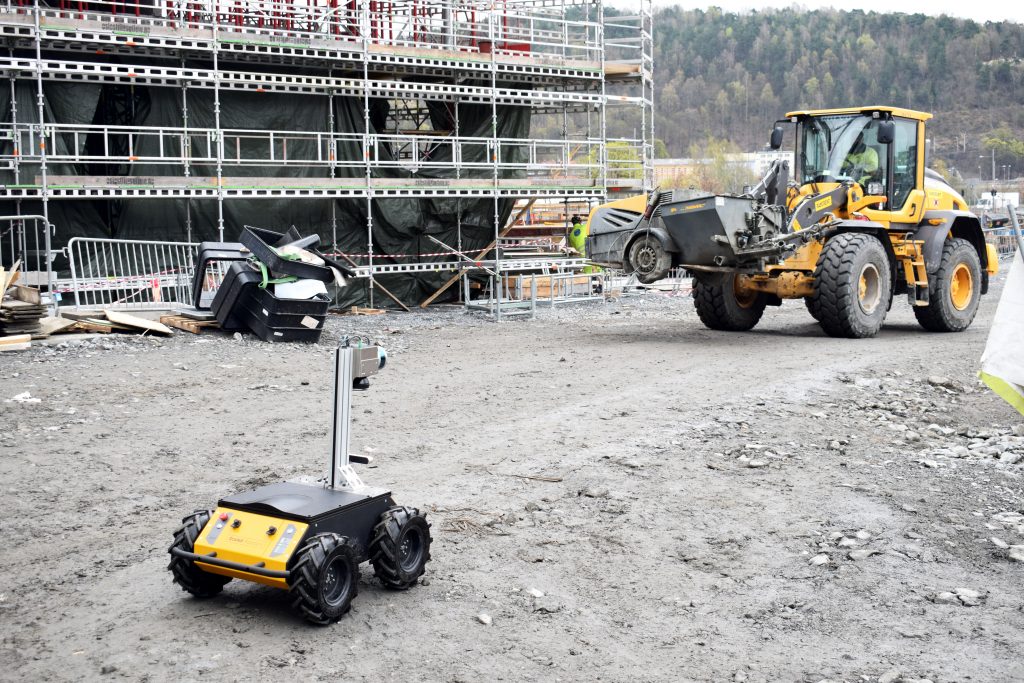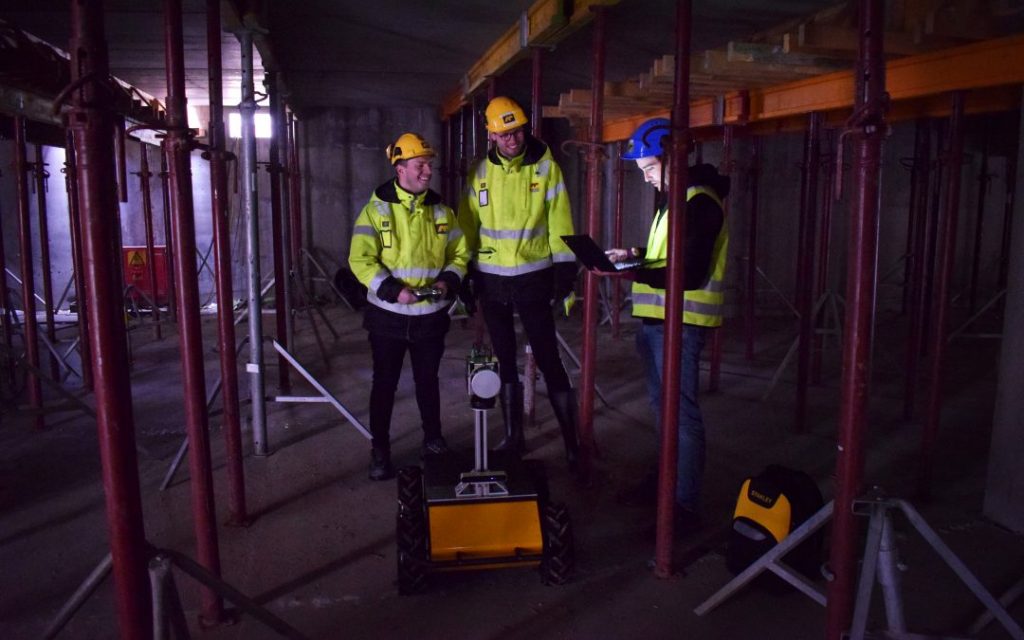
Scaled Robotics integrates mobile robot into construction site
Scaled Robotics has integrated a mobile robot called “Husky”, built by Clearpath Robotics, into a construction site’s activities
A construction site is an extremely busy, fast-paced, and interconnected environment. With specific building instructions and deadlines to meet, having a clear overview of the project is paramount.
Barcelona-based Scaled Robotics see the need to provide a beneficial service that has previously not existed in the construction industry.
Since it is virtually impossible to keep track of the hundreds of thousands of variable elements on a construction site, progress tracking was typically accomplished with very sparse spot checks.
These processes lead to costly construction errors due to misses or delays in detection, which subsequently results in very costly rework.

By utilizing Clearpath Robotics’ Husky UGV as a base for their autonomous construction verification, Scaled Robotics is on a mission to digitize construction.
Clearpath’s technology provides their customers the ability to keep track of their construction projects in real-time. This helps them prevent costly mistakes by quickly localizing errors and resolving them before they have very expensive downstream effects.
The Scaled Robotics team, on their mission towards modernizing construction with robotics and artificial intelligence, consists of a core team:
- Bharath Sankaran, CTO and co-founder;
- Stuart Maggs, CEO and co-founder;
- Abdo Roig, director of engineering;
- Pol Cirujeda, senior computer vision engineer;
- Alejandro Nespereira, computer vision engineer;
- Maria Artigas, robotics engineer; and
- Alexis Vassilipoulous, full stack engineer.
They hope to engineer significant change in their industry and continue to innovate with robotic solutions.
Helping project managers stay in the loop
With the help of the Husky UGV platform, Scaled Robotics want to provide construction project managers and other stakeholders with real-time feedback about the state of their construction projects.
Ultimately, this will help them optimize their process, reducing waste and cost overruns.
How do the robots do it though?
To begin, the mobile robots autonomously navigate around the construction site and capture data with multiple onboard sensors such as lidars, cameras, IMUs, and RGBD sensors.
This sensor suite is carried by the Husky UGV mobile base, whereas the onboard sensing and computer were developed in-house by Scaled Robotics.
The full loadout includes onboard computers, a dense stereo system, custom batteries, and a 4G router and network connectivity.
These sensors enable multi-modal data capture, on-board localization, SLAM and data transfer to the cloud.
Next, Scaled Robotics use the captured data to build metric maps and other representations of the environment which is compared to the digital (BIM) model of the building.
Finally, those analyses are used to ascertain the current state of the construction project and track its progress.
Clearpath Robotics lends a helping hand
However, their ambitious project wasn’t without challenges. The sensors and platforms that Scaled Robotics uses were not developed with construction sites as a target environment in mind.
They were developed for autonomous driving and navigation in outdoor or fully built indoor environments. Therefore, the team had to significantly adapt these systems to work for their target scenarios.
Construction environments, apart from being extremely cluttered and dynamic, are also constantly evolving.
Trying to localize in these settings is then pretty challenging since localization assumes a previously built map of the environment, which is never the case.
Every time you map on a construction site, it’s a new map of the environment and significantly different from the previous one.
Also, there’s very little navigable terrain, with lots of detractors like wet cement, water on the floor / water dripping from the ceiling, wires and pipes dangling from everywhere and so on.
There’s a reason they call it a concrete jungle. Scaled Robotics needed a rugged and durable platform like Husky UGV.
As for sensors, lidars were built for navigation/autonomous driving. Their primary objective is to sense and avoid, not accurately measure.
Therefore, most commercial grade lidars operate under a 2-3 cm range of accuracy. Construction, however, requires measurements that are accurate in the sub-centimeter range (mostly in the 5-10 mm range).
The only construction lidars that currently offer this degree of accuracy are prohibitively expensive.
Finally, construction sites are pseudo outdoor environments where you often operate in a partially closed environment with no walls.
So, while you cannot access GPS, you are still exposed to all the detractors of the outdoors, like wind, rain, snow, ambient lighting issues (because sunlight interferes with your lighting source).
This results in the worst of both worlds instead of the best.
To address the above issues, Scaled Robotics utilized Clearpath Robotics’ customer support, leveraging their expertise and insights into robotic integrations.
Without Clearpath Robotics’ products, Scaled Robotics would have had to use traditional construction laser scanners and also develop their own mobile platform. The main issues with that, however, were as follows:
- Traditional laser scanners are very time consuming to capture data
- An internally developed platform would not have been ready for field testing
Scaled Robotics have been very happy with using the Husky UGVs, especially because of the overwhelmingly positive feedback from all of their clients.
Furthermore, they believe that Clearpath Robotics’ customer service is great with a phenomenal support team, while their robots are easy to use and integrate and make for great research and prototype platforms.
Bharath Sankaran, CTO & co-founder, says: “We chose Clearpath’s solution because it is the best research-grade mobile robot on the market, that allows for rapid prototyping and quick integration.”
Success with Husky UGV
Right now, the set-up that Scaled Robotics has with the Husky UGVs is a prototype and alongside field testing and further applications, they hope to develop a more integrated platform in the future.
So far, the company has been successful in creating a large customer base in Europe and beyond, where their product has been piloted and adopted to track progress on construction sites.
Furthermore, their project has gained media traction in articles from TechCrunch and BIM+.
To conclude, they were also voted as one of the best robotics startups in Europe by RobotUnion and finalists for the Innovation Award at DCW 2018.
Scaled Robotics’ exciting work has enabled several key partnerships with some of the biggest construction companies in both Europe and globally, such as AF Gruppen, KIER, Dura Vermeer, Besix, and Vinci, where they are testing and deploying their technology.
They are also teaming up with Autodesk to integrate their tools to provide the best possible customer workflow and easy integration for their construction clients.
A construction site never stops moving, and neither will Scaled Robotics, say its staff.


